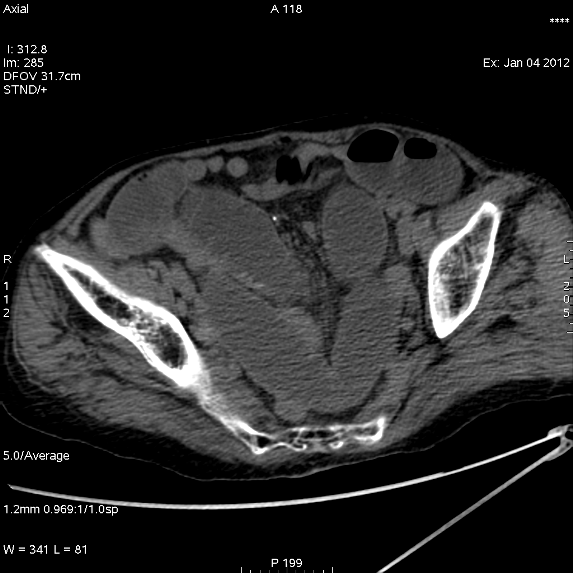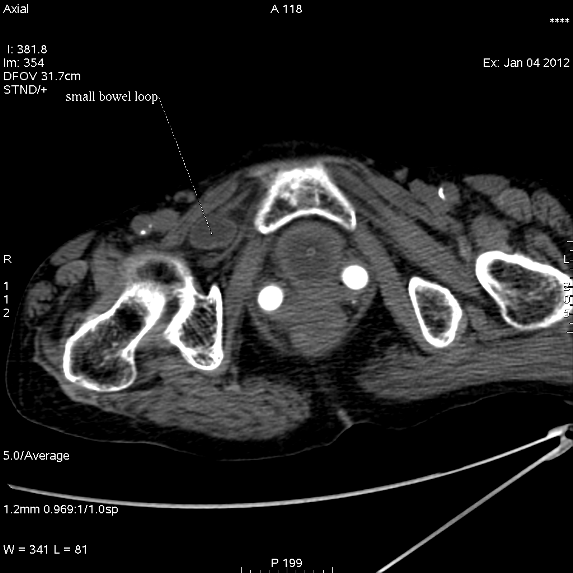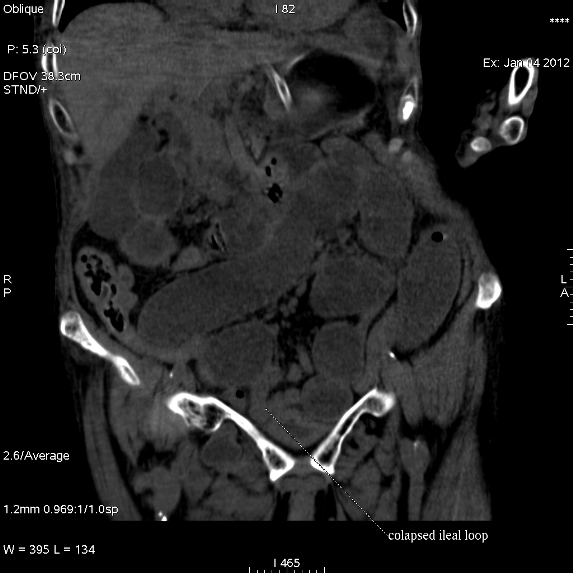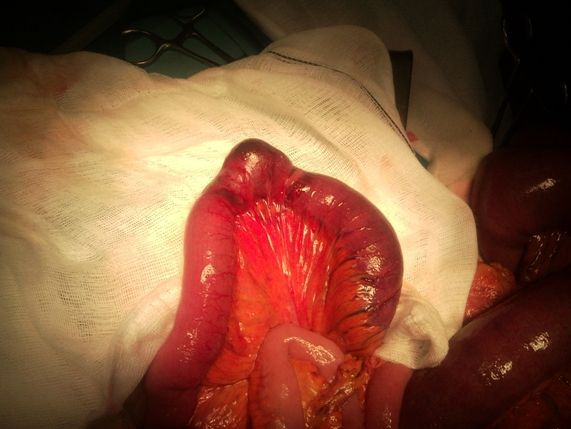Obturator Hernia
An 80-year-old woman with progressive abdominal fullness for two days, intermittent abdominal pain, nausea and vomiting
An 80-year-old woman was admitted to the emergency department with progressive abdominal fullness for two days, intermittent abdominal pain, nausea and vomiting. Her relevant medical history included mitral valve replacement 10 years ago with subsequent anticoagulation, type 2 diabetes mellitus, arterial hypertension and chronic renal failure, all of which controlled with medications. Physical examination revealed a distended abdomen without tenderness or muscle guarding. No mass was palpated in the bilateral groin. Rectal examination was negative.
Nonenhanced CT scan demonstrated obvious intestinal obstruction with a low density mass in the right obturator canal area.

Fig.1: Axial slice through the lower pole of right kidney demonstrated dilated, fluid filled small bowel loops and collapsed colonic loops. It is important to mention small amount of intraperitoneal fad, which bothered interpretation of CT findings and diagnosis.

Fig.2: Axial nonenhanced CT scan shows a combination of dilated and collapsed small bowel loops into the pelvis.

Fig. 3: Axial CT scan at the level of pelvic floor demonstrated fluid-filled mass located between obturator externus muscles and ipsilateral pectineus. Hyperdence vaginal ring and balloon catheter in the vesicle bladder are also visible.

Fig. 4: Oblique reconstruction of native abdominal and pelvic CT examination demonstrates the position of incarcerated small bowel loop in the right obturator canal.

Fig.5: Oblique reconstruction of native abdominal and pelvic CT examination shows collapsed lumen of the distal ileum, after the incarcerated intestinal segment.
Fig. 6 and 7: Intraoperative photographs shows the widened right obturator canal with incarcerated small bowel loop in it and the incarcerated small intestinal loop.


Diagnosis: Right obturaor hernia
Emergency laparotomy was performed. During the operation, a 10 cm loop of small intestine was revealed herniated into the right obturator canal. Proximal intestine dilated severely and distal intestine collapsed. The incarcerated intestine was reduced. Intestinal segmentectomy and simple suture closure of obturator foramen were performed.
Discussion: Obturator hernia is a rare variety of abdominal hernia and occurs through the obturator foramen in the pelvis with no external lump.It is significant cause of morbidity and mortality, especially in the elderly age group. The mortality rate of obturator hernia is highest among all abdominal wall hernias (range 13 percent to 40 percent) [1,2]. Obturator canal is 2 to 3 cm long and 1 cm wide, and contains the obturator nerve and vessels. It is bounded superiorly and laterally by the pubic bone and inferiorly by the obturator membrane.
Obturator hernia is nine times more common in females due to their wider pelvis, more triangular obturator canal opening and greater transverse diameter. It occurs most frequently in older age group between 70 and 90 years [3]. The preperitoneal fat around obturator vessels and nerves play a protective. Malnourishment facilitates hernia formation due to loss of supporting connective tissue.
In most cases, obturator hernia presents with intestinal obstruction of unknown cause. The hernia sac usually contains small bowel, especially ileum. Clinical signs due to compression of the obturator nerve are often observed. The most common sign is obturator neuralgia, presented as either hypo- or hyperanestesia from the inguinal crease to the anteromedial aspect of the thigh [4]. The Howship-Romberg sign is characterized by pain in the medial thigh and is observed in 15 percent to 50 percent of patients with obturator hernia [5].
Various imaging examinations have been applied to establish the diagnosis. CT scan is considered the gold standard for diagnosis, whereas ultrasonography, contrast studies, herniography and plain films are less specific [5]. It is minimally invasive, readily available and requires a short time. It is especially useful in the initial period when the patient has non-specific symptoms and vague clinical signs.
Fast and correct preoperative evaluation and early surgery is the key to prevent morbidity and mortality.
Maria Nedevska, MD, University Hospital “St.Anna” Sofia, Bulgaria
References:
1. Yip AW, AhChong AK, Lam KH. Obturator hernia: a continuing diagnostic challenge. Surgery 1993; 113:266-9.
2. Ziegler DW, Rhoads JE Jr. Obturator hernia needs a laparotomy, not a diagnosis. Am J Surg 1995; 170:67-8.
3. Bjork KJ, Mucha P Jr, Cahill DR. Obturator hernia. Surg Gynecol Obstet 1988; 167:217-22.
4. Hannington-Kiff JG. Absent thigh adductor reflex in obturator hernia. Lancet 1980; 1:180.
5. Kammori M, Mafune K, Hirashima T et al. Forty-three cases of obturator hernia. Am J Surg. 2004 Apr; 187(4):549-52.
The Reading Room Podcast: Current Perspectives on the Updated Appropriate Use Criteria for Brain PET
March 18th 2025In a new podcast, Satoshi Minoshima, M.D., Ph.D., and James Williams, Ph.D., share their insights on the recently updated appropriate use criteria for amyloid PET and tau PET in patients with mild cognitive impairment.
Meta-Analysis Shows Merits of AI with CTA Detection of Coronary Artery Stenosis and Calcified Plaque
April 16th 2025Artificial intelligence demonstrated higher AUC, sensitivity, and specificity than radiologists for detecting coronary artery stenosis > 50 percent on computed tomography angiography (CTA), according to a new 17-study meta-analysis.
New bpMRI Study Suggests AI Offers Comparable Results to Radiologists for PCa Detection
April 15th 2025Demonstrating no significant difference with radiologist detection of clinically significant prostate cancer (csPCa), a biparametric MRI-based AI model provided an 88.4 percent sensitivity rate in a recent study.